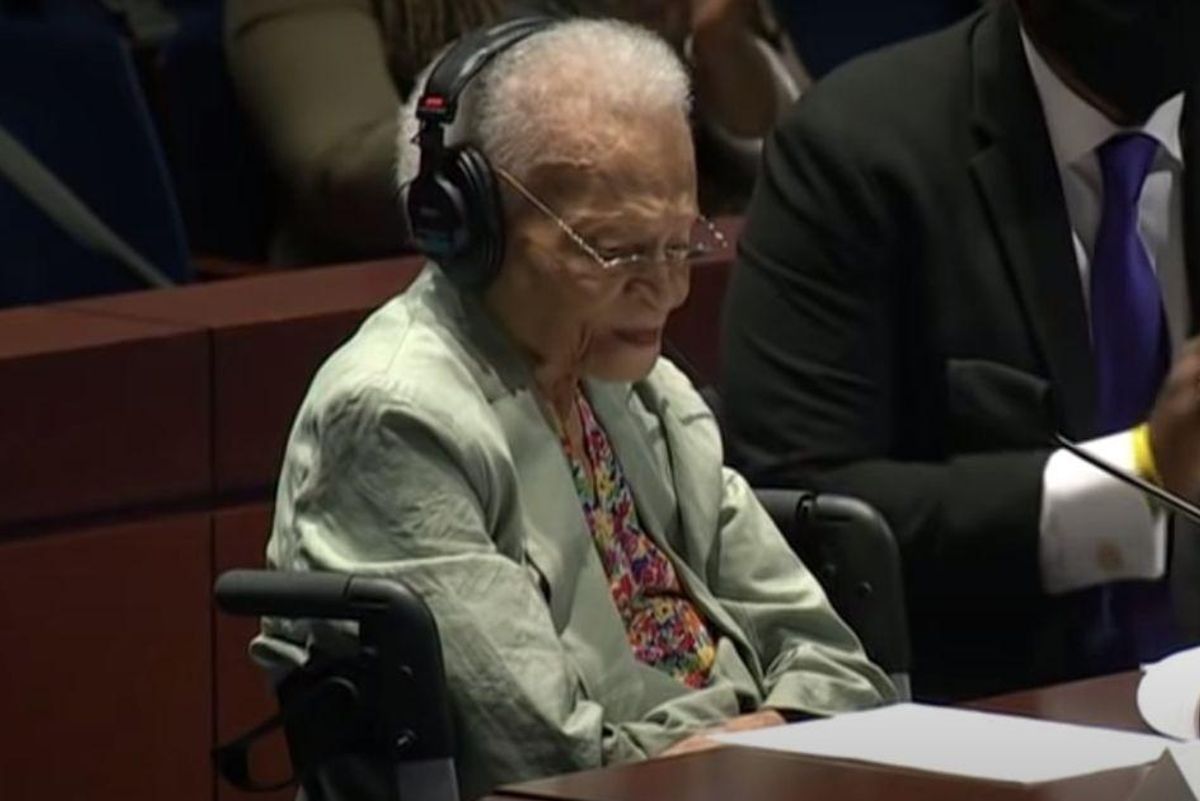A 107-yr-old witness to the Tulsa Race Massacre just gave a powerful testimony to Congress

One hundred years ago, the Greenwood district of Tulsa, Oklahoma was a bustling Mecca of Black-owned businesses and a community where Black Americans thrived. It was known colloquially as "Black Wall Street," and was an anomaly in a state where the KKK actively worked to keep Black people oppressed.
On May 31 and June 1, 1921, it all changed. An alleged assault attempt by a young Black man against a young white woman (which never amounted to anything, as all charges were dropped) sparked protests, violence, and ultimately, a massacre by white mobs who murdered, looted, and set fire to Black Wall Street. More than 1200 homes were destroyed, churches were burned, and businesses wiped out. Thousands of white people descended on Greenwood and obliterated 35 city blocks in 24 hours, causing irreparable financial damage in addition to the emotional toll of the massacre.
The death count has never been verified. One newspaper initially only reported that two white people were killed in the "race riot." Current estimates put the number killed at around 300, almost all of them Black residents. Thousands of those left behind had to live in tents and try to pick up the pieces of their lives, literally and figuratively.
But many Americans never learn this history. It has rarely been taught in schools, even in Oklahoma, partially because much of the documentation of the massacre was covered up. A 1997 commission organized by the city examined documents and interviewed survivors to piece together what really happened on those days, and they released a report on their findings in 2001. Of their many notable findings, the commission determined that white Tulsa officials participated in the violence, even providing the white mob with firearms and ammunition to terrorize the Black residents.
The massacre of Tulsa's "Black Wall Street"www.youtube.com
The survivors that the city interviewed are gone now, but there are still a few people left who witnessed the massacre.
107-year-old Viola Fletcher, the oldest living survivor, testified this week before the House Judiciary Subcommittee on Constitution, Civil Rights, and Civil Liberties, asking the U.S. to formally "acknowledge what happened in Tulsa in 1921" on its centennial. Her testimony was powerful.
"I still see Black men being shot, Black bodies lying in the street. I still smell smoke and see fire," Fletcher told lawmakers. "I still see Black businesses being burned. I still hear airplanes flying overhead. I hear the screams. I have lived through the massacre every day."
"I am 107 years old and have never seen justice," she said. "I pray that one day I will. I have been blessed with a long life -- and have seen the best and worst of this country. I think about the terror inflicted upon Black people in this country every day."
Watch her powerful 7-minute testimony:
POWERFUL: Oldest living survivor of Tulsa race massacre testifies in front of Housewww.youtube.com
Another survivor, 106-year-old Lessie Benningfield Randle also testified about what she witnessed when she was six.
"They burned houses and businesses. They just took what they wanted out of the buildings then they burned them," she said." They murdered people. We were told they just dumped the dead bodies into the river. I remember running outside of our house. I ran past dead bodies. It wasn't a pretty sight. I still see it today in my mind—100 years later."
The remaining survivors have called for reparations, citing the inability of the community to rebuild following the massacre, especially in light of the Jim Crow laws and racist economic policies that followed.
Many Americans tend to think of the history of blatant, violent, government-sanctioned racism as something in the distant past, but there are still people alive today who remember this massacre that took place in 1921. And that year was a mere 50 years after the start of the Civil War, which means many Black Americans living in the South at that time had been born into slavery. That history is simply not that far away.
All three of the testimonies from survivors of the Tulsa-Greenwood Race Massacre are powerful. You can watch the full House Judiciary hearing here:
Continuing Injustice: The Centennial of the Tulsa-Greenwood Race Massacrewww.youtube.com
- Here are some practical and important ways white Americans can ... ›
- She summed up the economic legacy of Black Americans in one ... ›
- Oklahoma leaders announce they'll finally start teaching about the ... ›





 Christopher Plummer and Julie Andrews on location in Salzburg, 1964
Christopher Plummer and Julie Andrews on location in Salzburg, 1964 Bed Bugs Belarus GIF
Bed Bugs Belarus GIF Bed bugs are about the size of an apple seed.
Bed bugs are about the size of an apple seed. bug GIF
bug GIF Checking mattresses for signs of bed bugs at a hotel can help you avoid bringing them home.
Checking mattresses for signs of bed bugs at a hotel can help you avoid bringing them home. shallow focus photo of boy in red crew-neck T-shirt
shallow focus photo of boy in red crew-neck T-shirt Teens playing table tennis
Teens playing table tennis two girl in pink and green shirts sitting on wall shelf
two girl in pink and green shirts sitting on wall shelf